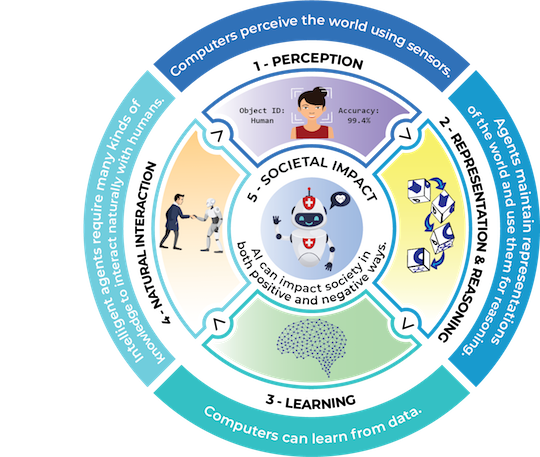Metadata
- Id: EU.AI4T.O1.M2.1.2t
- Title: 2.1.2 What is the definition of AI?
- Type: text
- Description: Present the diverse definitions of AI and its fields
- Subject: Artificial Intelligence for and by Teachers
- Authors:
- AI4T
- Licence: CC BY 4.0
- Date: 2022-11-15
What is the definition of AI?¶
An evolution in the definition¶
Giving a definition of AI is a complex task as there is no mutually agreed definition or taxonomy of AI1.
The term 'artificial intelligence' was first used in 1955 by McCarthy & al.2 to describe the "science and engineering of making intelligent machines, especially intelligent computer programs".
In 1968, an other father of AI, Marvin Minsky, has proposed a short definition of AI, arguing that it is "the science of making machine do things that would require intelligence if done by men"3.
Since then, the expression "artificial intelligence" is often used to refer to algorithms that simulate or share some of the intelligence capabilities of living beings.
On the European level, the High level expert group on Artificial intelligence proposes the following detailed definition, which is commonly referred to in the European commission works4:
"Artificial intelligence (AI) systems are software (and possibly also hardware) systems designed by humans that, given a complex goal, act in the physical or digital dimension by perceiving their environment through data acquisition, interpreting the collected structured or unstructured data, reasoning on the knowledge, or processing the information, derived from this data and deciding the best action(s) to take to achieve the given goal. AI systems can either use symbolic rules or learn a numeric model, and they can also adapt their behaviour by analysing how the environment is affected by their previous actions."
This description of AI is depicted on the following figure3.

A scientific representation¶
As a scientific discipline, AI covers several sub-areas of expertise and their associated techniques4. Some of them are often quoted, others less known.
- Machine learning (of which deep learning and reinforcement learning are specific examples),
- Machine reasoning (which includes planning, scheduling, knowledge representation and reasoning, search, and optimization),
- And robotics (which includes control, perception, sensors and actuators, as well as the integration of all other techniques into cyber-physical systems).

-
Joint Research Centre technical report: AI Watch: defining artificial intelligence - toward an operational definition and taxonomy of artificial intelligence (2020) - https://publications.jrc.ec.europa.eu/repository/handle/JRC118163 (consulted 08/19/2022) ↩
-
McCarthy, J., Minsky, M. L., Rochester, N., & Shannon, C. E. (2006). A Proposal for the Dartmouth Summer Research Project on Artificial Intelligence, August 31, 1955. AI Magazine, 27(4), 12. https://doi.org/10.1609/aimag.v27i4.1904 ↩
-
Minsky, M. L. Semantic information processing. Cambridge, MA: MIT Press quoted in. AI watch: defining artificial intelligence 2.0 - page 113 (op.cit) ↩↩
-
High-Level Expert Group on Artificial Intelligence: A definition of AI: main capabilities and disciplines (2019) https://digital-strategy.ec.europa.eu/en/library/definition-artificial-intelligence-main-capabilities-and-scientific-disciplines (consulted 08/19/2022) ↩↩